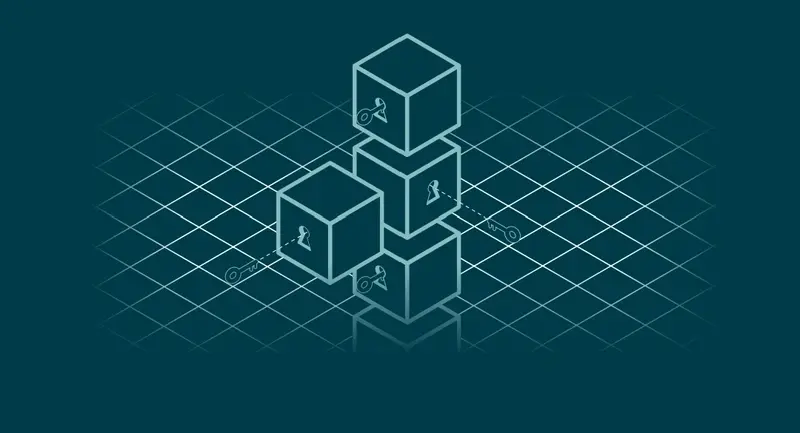
THIS IS AN ADVERTISING FEATURE
Blockchain technology is a global theme, potentially poised to benefit as governments and industries seek to improve the accuracy, transparency, and security of financial transactions. Blockchains and cryptocurrencies are closely linked, but the theme is much bigger than just digital assets.
What is Blockchain Technology and How do Blockchains Work?
A blockchain is a distributed database that can be viewed, accessed, and updated by any participant in the network. On a blockchain, data is aggregated into individual blocks that are linked together with prior blocks to form a chain. This data can represent a transfer of value or the settlement of any activity on an application. Together, the chain of individual blocks constitutes all the network’s historical data. Thanks to the cryptographic architecture of advanced blockchains, retroactive modification of past data is nearly impossible.
By requiring the database to be stored on all network computers and all updates to the ledger to garner a consensus among users, blockchains offer a secure and decentralised method of data management. This substantiates true digital ownership that cannot be revoked and creates a trustless and neutral settlement layer for data.
The spectrum of applicable use cases for this technology is wide. Because many of the most popular blockchains today support smart contract technology—the building blocks of decentralised applications (dapps)—blockchains have become viable data settlement layers for functions far beyond peer-to-peer value transfers.
The Relationship Between Blockchain Technology & Digital Assets
Blockchain technology is closely linked with cryptocurrencies and other digital assets. Cryptocurrencies are designed to serve as a medium of exchange that uses encryption techniques to control the creation of monetary units and to verify transactions. Beyond cryptocurrencies, tokenized securities or crypto-derivatives represent additional types of digital assets with potential value. Digital assets are primarily developed on blockchain networks where transactions are validated by independent nodes and propagated throughout the network on a peer-to-peer basis. Digital assets are typically traded through digital asset exchanges, but they can also be traded on a peer-to-peer basis directly on the blockchain.
Bitcoin, the best-known and largest cryptocurrency by market capitalization, was the first widespread application of blockchain technology. Benefitting from the unique aspects of blockchain technology, Bitcoin has never been hacked or compromised, it is not governed by a central authority, and its transactions are made transparent across the network. Bitcoin is often explained as “digital gold,” as many see it as a secure store of value that can also be used for transactions. Beyond Bitcoin, there are several types of cryptocurrencies that serve alternative purposes, like Ethereum’s ether. The Ethereum blockchain expands on the Bitcoin blockchain’s use case by incorporating a virtual machine that’s capable of executing more advanced programs (i.e. smart contracts). Ethereum is a programmable blockchain or, essentially, a decentralized computer that powers censorship-resistant applications that can be independently built and used by anyone. Transacting on the Ethereum network requires computational power, which users must pay for in the blockchain’s native token ether. Hence, demand for ether is partially tied to the utility provided from the applications built on the Ethereum blockchain.
Blockchain Use Cases Beyond Cryptocurrencies
Beyond cryptocurrencies, there are several valuable use cases for blockchain technology, including smart legal contracts, tracking and monitoring supply chains, and accessing and sharing health care records.
Just as email is one way to leverage the internet, Bitcoin and other digital assets are just one use case for blockchain. Virtually any capacity, regardless of industry or segment, that can benefit from the features of transparent, verified transactions and immutable data entry and record keeping could find value in implementing blockchain technology.
To understand how the blockchain can provide value, it’s important to contrast it with traditional record-keeping. Historically, each party manages its own centralised ledger and tries to reconcile transactions between them. For example, businesses and their suppliers must relay information to each other on invoices, goods sold, deliveries, inventories, and more. Each group must be satisfied that the other’s data is valid, while discrepancies can create major headaches that need to be resolved. With blockchain, all groups operate with the same datasets, trust that the data and transactions are recorded accurately, and have transparency into historical transactions. Below are just a few examples of the technology’s potential:
- Supply Chains: Supply chain transparency is the rule today, not the exception. Consumers want to know the backstories of the products they buy and accountability from the companies who make and distribute them. As a result, supply chain management is critical. But keeping tabs on a product’s journey can be costly, time-consuming, and fraught with risk for companies. An intriguing solution to modern supply chain management is blockchain technology. Blockchain’s secure, easily trackable ledger creates efficiencies for the entities that work to get products into consumers’ hands. Blockchain can be particularly useful when things go wrong. For example, an interesting use case is in the grocery space. Food isn’t just a product, it’s a product that affects public health. So, a contaminated food shipment, like the 2019 romaine lettuce E-coli incident in the U.S., is a risk with far-reaching implications. For grocers, traditionally, news of such an outbreak could mean pulling the entire inventory off the shelves. But with blockchain, they could quickly track the contaminated inventory back to the source, preserve the uncontaminated inventory, and help prevent future outbreaks.
- Health Care Tracking: Today, patient health records are fragmented and stored as a mix of paper and electronic health records (EHRs) at different service providers’ facilities. This structure makes it very challenging to visualize and share a patient’s historical data in real time. EHRs have improved as different health providers share the data digitally. However, it remains a challenge to effectively combine all records into a single platform and manage the governance and security of the information via a centralized system. Such a centralized architecture has some drawbacks, as it could face the risk of a single point of failure or bottlenecks of data flow when the system becomes larger.1 Health records could be effectively stored in a blockchain by using a unique patient identifier, allowing patients to access their own records and authorise health service providers to access the information in real time.
- Smart Contracts: Smart contracts are a set of predetermined rules by which blockchain transactions can occur. These rules are structured by “if/when” parameters followed by “then.” This automated approach can execute a contract only if all pre-determined conditions are met, allowing all the participants to be certain of the outcome. Examples of these transactions are selling digital art, releasing funds, real estate title transfers, and insurance claims. Once the transaction is finalized, it’s recorded in a blockchain, meaning that it cannot be changed or eliminated, and all the parties involved can have access to it. Smart contracts can increase the efficiency of transactions since there is no paperwork involved and no time spent reconciling errors; they are secured by encryption mechanisms; and they can be fully trusted by participants since they’re decentralised and transparent.
Related ETF
The Global X Blockchain UCITS ETF (BKCH) seeks to invest in companies positioned to benefit from the increased adoption of blockchain technology, including companies in Digital Asset Mining, Blockchain & Digital Asset Transactions, Blockchain Applications, Blockchain & Digital Asset Hardware, and Blockchain & Digital Asset Integration.
The breakdown of BKCH often leans toward Digital Asset Mining firms and Blockchain & Digital Asset Transactions companies, as these segments of the public equity markets are more developed and feature among the largest companies in the blockchain ecosystem. Because these firms derive a substantial portion of their revenue based on the price of crypto assets, the fund often exhibits a meaningful correlation to cryptocurrency prices, particularly Bitcoin. As blockchain technology reaches further adoption beyond cryptocurrencies, we would expect to see Blockchain Applications and Blockchain & Digital Asset Integration companies become growing segments of the portfolio.
Capital at risk: The value of an investment in ETFs may go down as well as up and past performance is not a reliable indicator of future performance.
Footnotes
- Dara Tith et al., “Application of Blockchain to Maintaining Patient Records in Electronic Health Record for Enhanced Privacy, Scalability, and Availability,” Jan 31, 2020.
The Global X UCITS ETFs are regulated by the Central Bank of Ireland.
This is a marketing communication.
Please refer to the relevant prospectus, supplement, and the Key Information Document (“KID”) of the relevant UCITS ETFs before making any final investment decisions.
Investors should also refer to the section entitled “Risk Factors” in the relevant prospectus of the UCITS ETFs in advance of any investment decision for information on the risks associated with an investment in the UCITS ETFs, and for details on portfolio transparency. The relevant prospectus and KID for the UCITS ETFs are available in English at www.globalxetfs.eu/funds.
Investment in the UCITS ETFs concern the purchase of shares in the UCITS ETFs and not in a given underlying asset such as a building or shares of a company, as these are only the underlying assets that may be owned by the UCITS ETFs.
A UCITS ETF’s shares purchased on the secondary market cannot usually be sold directly back to a UCITS ETF. Investors must buy and sell shares on a secondary market with the assistance of an intermediary (e.g. a stockbroker) and may incur fees for doing so. In addition, investors may pay more than the current net asset value when buying shares and may receive less than the current net asset value when selling them. Changes in exchange rates may have an adverse effect on the value price or income of the UCITS ETF.
Past performance of a UCITS ETF does not predict future returns. Future performance is subject to taxation which depends on the personal situation of each investor, and which may change in the future. Neither past experience nor the current situation are necessarily accurate guides to the future growth in value or rate of return of a UCITS ETF.
Investment may be subject to sudden and large falls in value, and, if it is the case, the investor could lose the total value of the initial investment. Income may fluctuate in accordance with market conditions and taxation arrangements. The difference at any one time between the sale and repurchase price of a share in the UCITS ETF means that the investment should be viewed as medium term to long term.
Any investment in a UCITS ETF may lead to a financial loss. The value of an investment can reduce as well as increase and, therefore, the return on the investment will be variable.
Global X ETFs ICAV is an open-ended Irish collective asset management vehicle issuing under the terms of its prospectus and relevant supplements as approved by the Central Bank of Ireland and is the issuer of certain of the ETFs where stated.
Global X ETFs ICAV II is an open-ended Irish collective asset management vehicle issuing under the terms of its prospectus and relevant supplements as approved by the Central Bank of Ireland and is the issuer of certain of the ETFs where stated.
Communications issued in the European Union relating to Global X UCITS ETFs are issued by Global X Management Company (Europe) Limited (“GXM Europe”) acting in its capacity as management company of Global X ETFs ICAV. GXM Europe is authorised and regulated by the Central Bank of Ireland. GXM Europe is registered in Ireland with registration number 711633.
Communications issued in the United Kingdom and Switzerland relating to Global X UCITS ETFs are issued by Global X Management Company (UK) Limited (“GXM UK”), which is authorised and regulated by the Financial Conduct Authority. The registered office of GXM UK is 77 Coleman Street, London, EC2R 5BJ, UK. Information about GXM UK can be found on the Financial Services Register (register number 965081).
Information for Investors in Switzerland
This is an advertising document. The state of the origin of the fund is Ireland. In Switzerland, the representative is 1741 Fund Solutions AG, Burggraben 16, CH-9000 St.Gallen. The paying agent is Tellco AG, Bahnhofstrasse 4, 6430 Schwyz.
The prospectus, the key information documents or the key investor information documents, the articles of association as well as the annual and semi-annual reports may be obtained free of charge from the representative.
Past performance is no indication of current or future performance. The performance data do not take account of the commissions and costs incurred on the issue and redemption of units.




